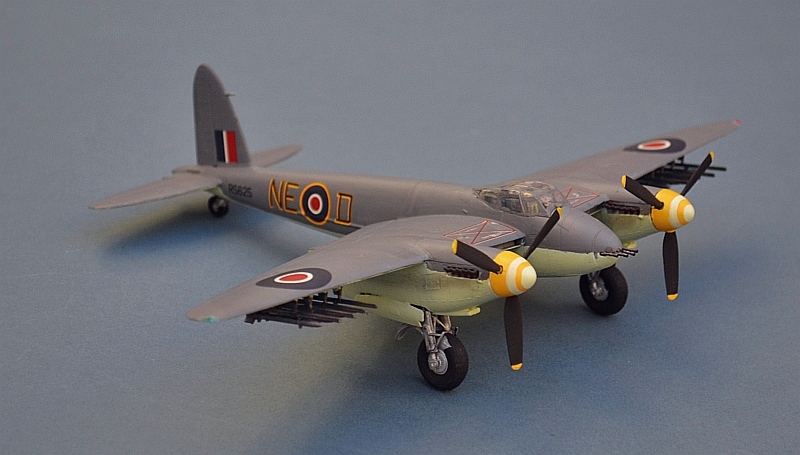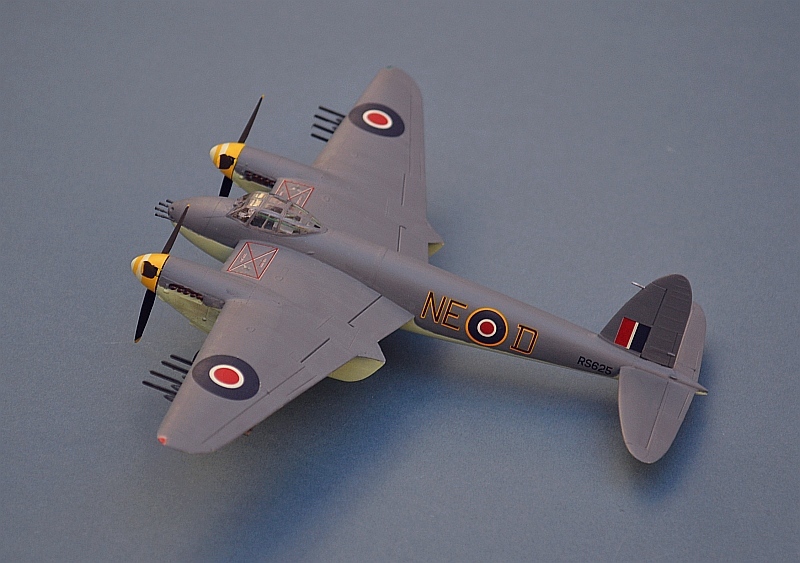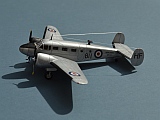October 2014
DeHavilland Mosquito
Beech Expeditor
![]() Selected WW2 70th Anniversaries this month:
Selected WW2 70th Anniversaries this month:
Between 2009 and 2015, I have set myself a general modelling theme based on selected 70th Anniversaries from WW2.
In Europe, the end seems near. Much of France and Belgium are liberated, and the Germans are falling back toward the Ardennes.
In the east, the Red Army’s advance through Poland seems unstoppable.
12 October 1944 -
14 Oct -
20 Oct -
21 Oct -
25 Oct -
30 Oct -
De Havilland Mosquito FB Mk.VI
143 Sqn RAF Coastal Command
RAF Banff, Aberdeenshire, October 1944.
Hasegawa 1/72
143 Sqn was a Coastal Command Fighter Squadron, based out of North Coates and various RAF bases in the South West. In September 1944 the Squadron transitioned to the Mosquito from its Beaufighters and moved to RAF Banff in Scotland.
As part of the Banff Strike Wing it conducted anti-
www.gengriz.co.uk
Background Image: Bf109 Trop at the RAF Museum Hendon
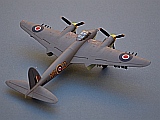
Tamiya have a well earned reputation for producing superbly engineered kits. 1/72
is not their normal scale (most Tamiya 1/72 kits seem to be Italeri-
Almost perfect fit, very well judged surface detail and a reputation for accuracy make this a desirable and very pleasing kit to build.
This kit came to me courtesy of Mrs T, who found it in a charity shop for the grand sum of £2, rather roughly built and unpainted. Fortunately I already have the same kit in the stash for a future project, allowing me to use the spare decals to refurbish this one
Fixed wing aircraft of the Royal Air Force (1918-
(including Commonwealth Air Forces and all with some sort of naval connection!)
Friends & Allies IndexRAF 1945 to presentUSN, USMC & USAFNATO & othersMirage & Rafale
Supermarine Spitfire Vb, 249 Sqn RAF, HMS EAGLE / RAF Takali, Malta 1942
This is the old Airfix Mk Vb Spitfire kit, which can definitely still hold its own with more modern kits. I have made some very small modifications; the distinctive Volkes tropical air filter under the nose, using the parts from an Airfix Mk Vc kit, a shorter blunter propeller boss and a seat harness. Link to build page
7 March 1942 saw the first deliveries of 15 Spitfire Vb aircraft to the the besieged island of Malta. Transported through the Mediterranean by sea and launched from the flight deck of the carrier HMS EAGLE, at a distant position some 650 miles from the island, the Spitfires were escorted across the Med by Blenheims and shepherded in to land by Malta's Hurricanes.
Their timely arrival at the height of the siege gave the defending air forces an
aircraft that could out-
The aircraft depicted by this model was flown by Flying Officer Robert McNair RAF, who claimed one damaged enemy aircraft (a Bf109) on the 18th March 1942.
A Spitfire flies from the deck of HMS EAGLE on its way to Malta
© IWM (A7839)
Click to see a larger image
© Image Copyright Bruce McNair.
Used with kind permission
Post Building Note: Robert "Buck" McNair's son has been kind enough to get in touch with me and forwarded a copy of his father's logbook covering the events of 1st to 29th March 1942, including record of the damaged Bf109 on the 18th March (one of 4 sorties McNair flew that day).
To see the logbook page in full, please click on the thumbnail image at the left
As built, the Spitfire was equipped with simple 2 position flaps (either fully open
or fully closed), intended for landing only. To enable them to take off safely from
EAGLE's short 660 ft deck, wooden wedges were jammed into the flaps to prevent them
closing fully. After take-
This was the first ever deployment of the Spitfire outside the European theatre; a second delivery of 9 Spitfires from HMS EAGLE arrived on 21 March. The fact that they could be spared from the defence of the UK was a clear a reflection of the growing strength and confidence of the British forces. The crews adopted the same tactics that had served so well during the Battle of Britain 2 years earlier; Spitfires stayed high and engaged the escorting fighters, whilst the Hurricanes attacked the bombers flying below.
Handley Page Hampden, 49 Sqn, RAF Bomber Command, Scampton 1940.
Another re-
The HP52 Hampden medium bomber was designed to the same specification as the Whitley
and Wellington, but adopted a rather different design approach, placing the crew
in a very narrow forward pod and adopting a long slender boom to hold the tail assembly,
not unlike Dornier's "Flying Pencil" Do-
Hampdens quickly assumed the less risky night bombing role, including mine laying of German ports. Along with the Wellington, they bore the brunt of the RAF medium bombing effort during the early years of the war and participated in many of the early bombing raids on Germany, including raids on Berlin 70 years ago this month.
Later on, Hampdens were fitted with torpedoes and used very successfully by Coastal
Command and the Soviet Navy in anti-
Boulton Paul Defiant NF.1, 256 Sqn, RAF Catterick/RAF Prestwick 1940.
This is the Airfix kit in its current (2008) issue. The kit is infamous for its glaring inaccuracies, most noticeably the incredibly skinny nose. Nevertheless, with a little putty and plastic card, it can at least be converted into something that looks like a Defiant! Link to Build Page
The Defiant represented an evolutionary cul-
Thanks to the element of surprise, the Defiants' first daytime encounters were successful, with no less than 38 kills on one day. However, the Luftwaffe quickly changed tactics, attacking from ahead or underneath (Defiants had no forward firing guns), with depressingly predictable results. The RAF's losses were unsustainable ("its not aircraft we need, its pilots"), so it was rapidly transferred to night operations where it was not vulnerable to escorting fighters. It was remarkably successful in this role; indeed, most German aircraft shot down during the London Blitz were the victims of Defiant night fighters. However, the Defiant's glory was short lived and it soon passed to support roles, as target towing aircraft with the RAF and Fleet Air Arm.
Defiants from 125 Sqn, based at Rerne played a significant but largely ineffective role in the Bath Blitz, during the infamous April 1942 Baedeker raids, named after the famous German Tourist handbook. In retaliation for the RAF's destruction of cultural sites in Lubeck and Rostock, the Luftwaffe vowed to destroy every British city with more than 3 stars in the guidebook. Despite the city hosting 2 key operational night fighter bases and 10 Group's Sector Control HQ at RAF Box, the attackers circled unmolested above the city of Bath on 2 consecutive nights, destroying much of the city centre and killing over 400 inhabitants. At least part of the reason for this ineffectiveness was that 125 Sqn were half way through converting from the Defiant to the Beaufighter and not fully worked up in their new tactics. 87 Sqn's Hurricane night fighters, from RAF Charmy Down just outside the city, found it equally difficult to attack because the Nazi aAF Colircraft were flying in tight circles and unusually low (the bombers, having dropped their bomb loads, were now strafing civilians on the streets). As the next night's second raid unfolded (that night, the German aircraft, astonished by the lack of any defence, had returned to France, refuelled and flown back for a second go), out of sheer desperation, several RAF aircrew abandoned their Beaufighters and reverted to their familiar, but recently decommissioned Defiants, sadly to little effect; one aircraft managed to hit a Ju88, causing minimal damage before crash landing back at Colerne, another attacked the raiders only to find that his gun firing mechanism had been dismantled, whilst a third failed to join the fray at all, due to an intercom failure.
Armstrong Whitworth Whitley Mk VII, 612 Sqn RAF Coastal Command,
RAF Wick, Scotland, March 1943.
The old FROG Whitley is long past its best, but still conveys the brutalist lines
of this important ant-
First flying in 1936, the Whitley along with the Hampden and Wellington carried the
brunt of RAF heavy bomber activity during the early parts of WW2, including the first
RAF bombing raids on German territory. An awkward looking aircraft with a strange
nose-
Whitleys were allocated to the night bombing role from the start and thus never experienced
the dreadful casualties seen by their peers. This, combined with docile and reliable
handing, resulted in the aircraft gaining a very popular reputation with RAF crews;
in addition it meant that there were always plenty of Whitleys around, allowing it
to be converted for many other tasks. By 1942, fitted with anti ship radar in its
comparatively roomy fuselage, additional fuel tanks in the bomb bay and carrying
an extra crew member for extended patrols, long range Whitley Mk VIIs were in wide
service with Coastal Command, achieving their first U-
Although production of the Whitley ceased in June 1943, a great many Whitleys remained
in service with special operations and airborne forces squadrons right up to the
end of the war, conducting covert and clandestine insertions of troops and agents
by parachute into occupied Europe. The Fleet Air Arm also operated a number of Whitleys
as a multi-
612 Sqn RAF operated the Whitley on Anti-
Consolidated PBY-
RAF Killidas, N. Ireland 1943.
The Airfix Catalina amphibian is a fairly old kit, which doesn't really match up to today's standards. Its a fun build though, especially with all those working features!
The Catalina is perhaps the most successful seaplane ever built and played a key
role in the Battle of the Atlantic, attacking surfaced U-
Scottish RAF Catalina pilot, Flying Officer John Cruickshank of 210 Sqn RAF, was awarded the Victoria Cross, one of four VCs awarded to Coastal Command during WW2:
On 17 July/18 July 1944 Flying Officer Cruickshank, on anti-
In 2013 John Cruickshank was guest of honour at the RAF Benevolent Funds celebration of the 70th Anniversary of the Battle of the Atlantic. He is the last surviving recipient of the VC for air action in World War II.
On 7 May 1945, a Catalina of No.210 squadron RAF (formed as Naval 10 Sqn, RNAS) sank
the 196th and last U-
Curtis P-
112 Squadron RAF, 239 Wing, Western Desert Air Force,
Amriya South LG.91, Egypt, August 1942
Hasegawa's P40E kit is one of their very first engraved moulds and is a joy to build. Fit is near perfect, detail is restrained but adequate.
Early in 2012, an abandoned P-
The P-
Nearly 14,000 P-
P-
The first ever USAAF combat victory against a Luftwaffe aircraft was claimed in August
1942 by a P-
Martin A-
Western Desert Air Force, November 1942.
Frog 1/72: first issued in 1963, the kit is very basic, representing (I think) the later Mk IV variant. Parts fit is variable; the wings and fuselage fitted very well, but the wing and tailplane to fuselage joints were very bad. Panel lines are lightly raised, but the transparencies are thick and not particularly clear, even after dipping in Klear. My kit had no transfers with it, so these are some generic ones from my spares box. Link to Build Page
The Baltmore was a highly successful development of Martin's earlier Maryland light bomber, with a larger fuselage and other improvements produced at the request of the French and the RAF.
The aircraft served in significant numbers with RAF and Commonwealth squadrons (Australian & SAAF) in North Africa and the Mediterranean, as the light bomber backbone of the Desert Air Force. Its narrow and deep fuselage, reminiscent of the Hampden, was not an ideal layout, severely limiting the ability of the crew to move around the aircraft, but its high speed, agility and reasonable bomb load were a welcome addition to the Allied air forces.
The Mark IIIa was the first Baltimore variant supplied as Lend-
After WW2, the robust and lightweight Baltimore saw further service as a high speed research aircraft with the US Navy, capable of Mach 0.74 in a dive.
Bristol Type 156 Beaufighter TF. X, 236 Sqn RAF Coastal Command,
RAF North Coates 1944.
Another ancient Airfix kit, this mould was first issued in 1958! There are many more modern Beaufighter kits around, but this one is still fun!
The Bristol Beaufighter was developed from the Blenheim and the Beaufort torpedo bomber. By using the main assemblies from the Beaufort, its development was exceptionally fast; confidence was so high that a 300 aircraft production contract was placed with Bristol before the prototype had first flown.
Originally employed as a night fighter, later on it made its mark as a torpedo and
rocket armed anti-
The North Coates Strike Wing of RAF Coastal Command was the largest and most successful
dedicated anti-
Bristol Type 142 Blenheim Mk. IV F, 254 Sqn RAF Coastal Command,
RAF Stradishall, September 1940.
Yet another vintage Airfix kit, this mould was first issued in 1968.
The Bristol Blenheim formed the mainstay of Bomber Command during the early years
of WW2. When it first entered service, it was faster than most contemporary fighters,
but by 1940 it had been outclassed, and suffered badly during the Battle of France.
number of RAF squadrons used the Blenheim as a fighter, both within Fighter Command
and Coastal Command, where Blenheims often flew top-
Miles Master Mk.III, RAF Training Command, August 1941.
The ancient Frog kit of the Master remains available from various Eastern European sources. Although lacking in details (for example in its entirely bare cockpit), in its original Frog issue it is a nicely engineered kit and a worthy representation of this key WW2 Trainer.
The Miles Master was one of the most important British fighter trainers of WW2. Over
3,000 were built by Phillips & Powis Aircraft Ltd at Woodley in Berkshire. Originally
powered by an in-
Brewster B-
Sembawang, Singapore & Ipoh/Kuala Lumpur, Malaysia, December 1941
A slightly newer Airfix mould; as one of the last Airfix kits to be issued in poly bags, I beieve it hails from the early 1970s (although strangely, the Arthur Ward Airfix book does not mention its release date). Its nicer than the Matchbox equivalent and an easy build, although you need to get rid of those rivets!
Brewster's stubby Buffalo fighter was a reasonable design, let down by extremely poor build quality arising largely from Brewster's lack of volume manufacturing experience.
In Finnish hands, after a local re-
The original batch of Buffaloes procured for the RAF by the British Purchasing Commission in Washington were quickly diverted to the Far East and issued to Commonwealth squadrons, including 453 Sqn RAAF. Following the Japanese invasion of Malaysia on 8th Dec, 453 moved north to Kuala Lumpur and Ipoh airfields, to provide close support to the defending Commonwealth troops.
After 3 weeks of intense fighting, 453 was withdrawn to Singapore on 24th December with only 6 aircraft remaining serviceable. The squadron continued to fight in Malaysia and over Singapore until February 1942, managing to achieve a creditable kill ratio of 2:1 despite the limitations of the Buffalo and the desperate operational situation.
453 Squadrons was assigned to support Force Z, led by battleships HM Ships PRINCE
OF WALES and REPULSE, on their ill-
At the last minute, the Captain of REPULSE, defying his Flag Officer's orders, broke wireless silence to radio for help; Buffaloes from 453 Sqn were quickly on the scene, but it was too late.
Avro Lancaster B Mk. III Special (Type 464 Provisioning)
617 Sqn Royal Air Force "The Dambusters" RAF Scampton, 16/17 May 1943
This is the ancient Revell GB Dambusters kit from the 1960s. Not really up to modern standards, but still great fun to build. Link to Build Page
Entering service in 1942, the Avro Lancaster quickly became the mainstay of the RAF heavy bomber force. Powered by 4 Rolls Royce Merlin engines, it was reliable, handled well and could carry a significant bomb load in its long unobstructed bomb bay.
On the evening of 16th May 1943, specially modified Lancasters of 617 Sqn RAF undertook a daring and skillful raid on the Ruhr dams, using a novel bouncing bomb designed by Barnes Wallis and known as UPKEEP. The raid was judged successful, with the Mohne and Edersee dams breached and the Sorpe Dam damaged. However, 8 of the 19 Lancasters that took part in the raid did not return, with 53 aircrew killed and 3 taken prisoner.
The Dambusters raids proved a major boost to Allied morale, but due to a lack of effective follow up action, their military effect was limited. Unfortunately, over 3,000 people died as a result of the flooding, nearly half of whom were Prisoners of War or forced slave labourers from Nazi occupied countries.
Disruption to the industrial Ruhr valley was significant but short lived; critical
hydro-
CAC13 Boomerang, 4 Sqn Royal Australian Air Force
Shaggy Ridge, Ramu Valley, Finnisterre, New Guinea, January 1944
The Airfix boomerang is an old kit, simple and rather crude, but still entirely buildable.
My list suggests it was first issued in 1965, but mine is a 1990s issue, with typically
poor Heller-
During the early years of WW2, Australia began to be alarmed by the prospect of British-
The Boomerang was one of the latter, evolved from the DOuglas Harvard and CAC Wirraway, it wa sintended as a fighter, but found its niche in the close ground support role over the jungles of New Guinea and Bougainville, where it operated in a close team arrangement with Corsair aircraft of the Royal New Zealand Air Force.
Main Index
© www.gengriz.co.uk
De Havilland Mosquito FB Mk.VI, 143 Sqn RAF Coastal Command
RAF Banff, Aberdeenshire, October 1944.
Tamiya have a well earned reputation for prodicing superbly engineered kits. 1/72
is not their normal scale (most Tamiya 1/72 kits seem to be Italeri-
Almost perfect fit, very well judged surface detail and a reputation for accuracy make this a desirable and very pleasing kit to build.
143 Sqn was a Coastal Command Fighter Squadron, based out of North Coates and various RAF bases in the South West. In September 1944 the Squadron transitioned to the Mosquito from its Beaufighters and moved to RAF Banff in Scotland.
As part of the Banff Strike Wing it conducted anti-
This kit came to me courtesy of Mrs T, who found it in a charity shop for the grand sum of £2, fully built but unpainted. Fortunately I already have the same kit in the stash for a future project, allowing me to use the spare decals to refurbish this one.
Have a look at my "Friends & Allies" pages for details of my other WW2 RAF aircraft models
PM models have a very mixed reputation, ranging from reasonable to very poor.
Their C-
This one has a set of home-
The Beech Model 18 saw widespread military and civilian use as a light communications transport and trainer. It remained in production from the late 1930s until 1970, holding the record for the longest continuous production of a piston engined aircraft.
Have a look at my "RN Flight Deck" pages for details of my other naval aircraft models
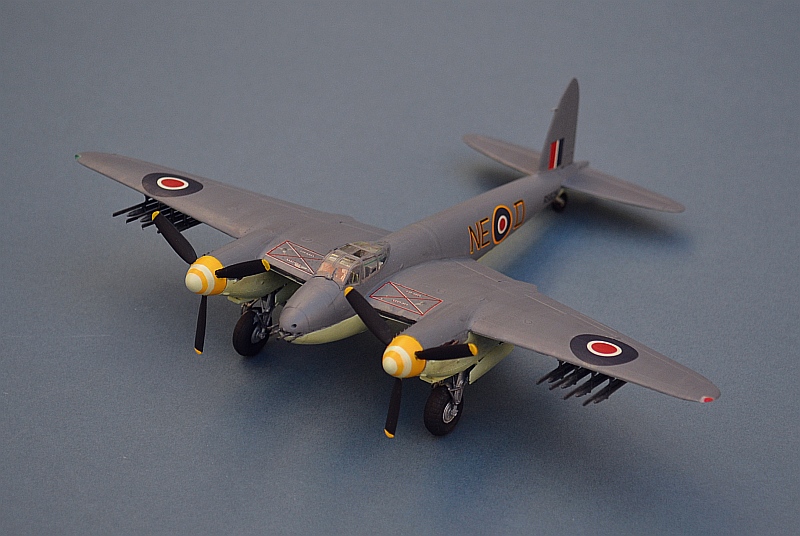
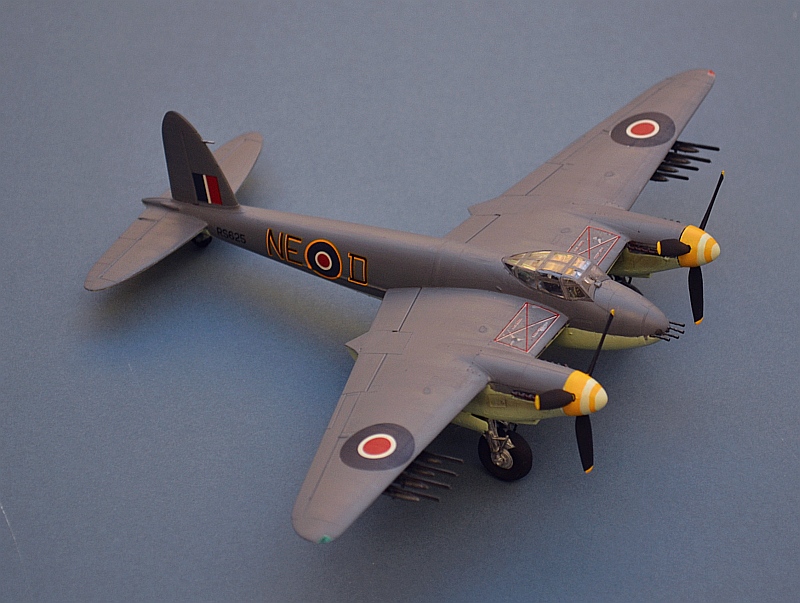
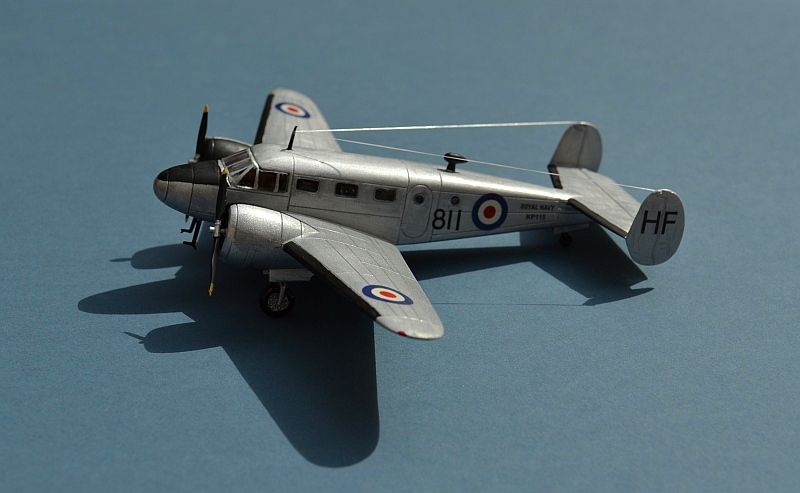
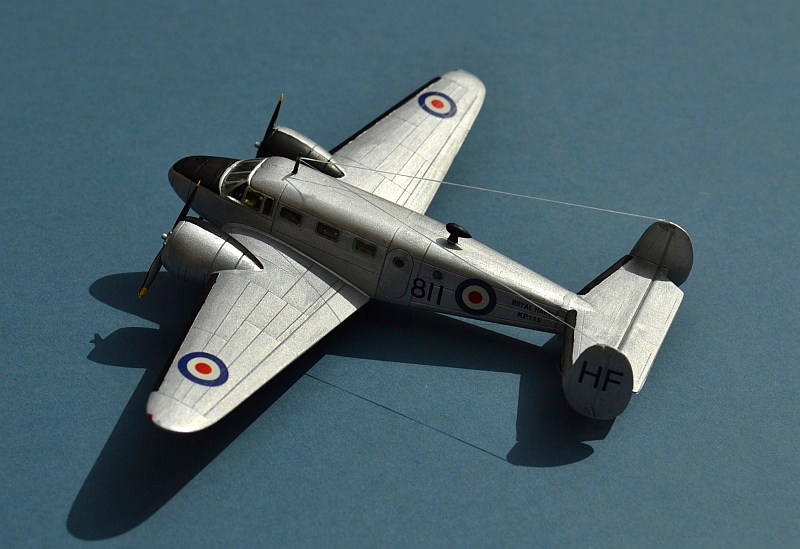
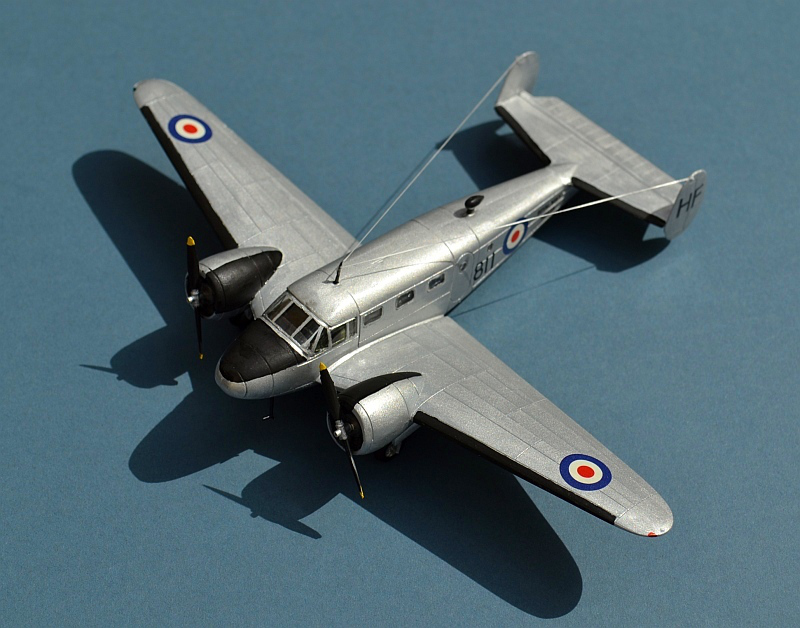
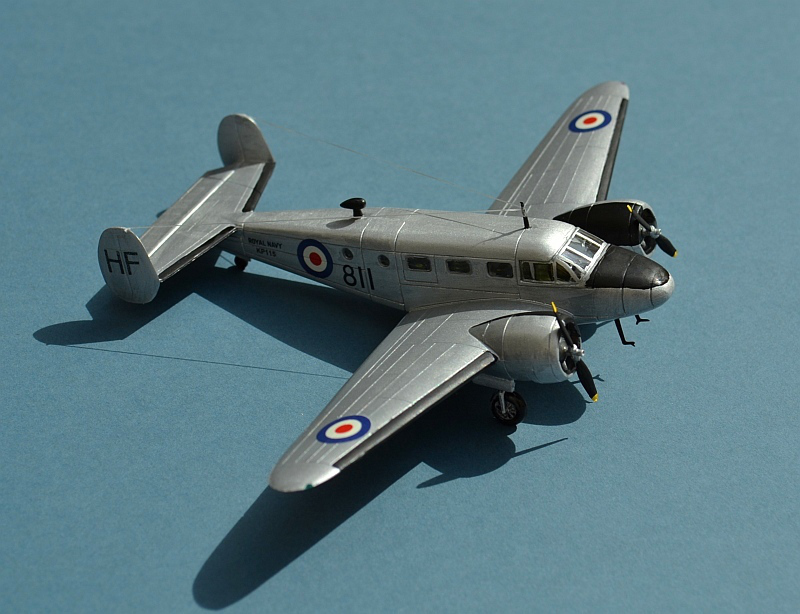
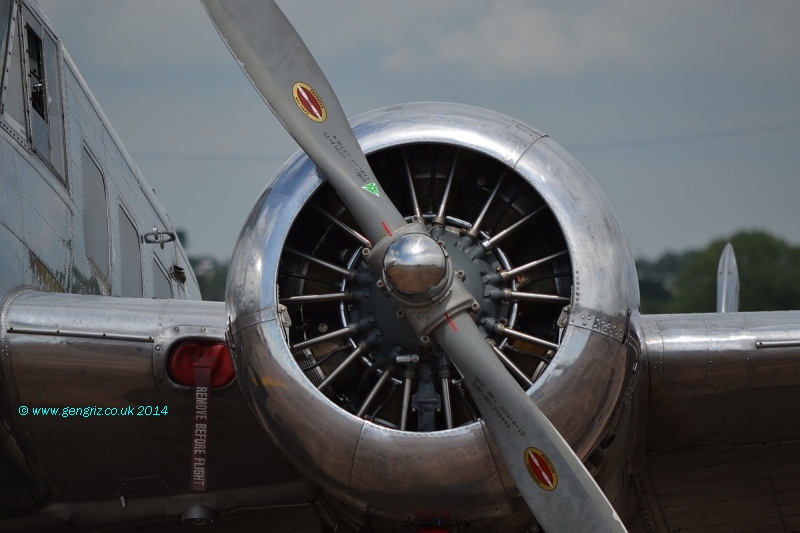
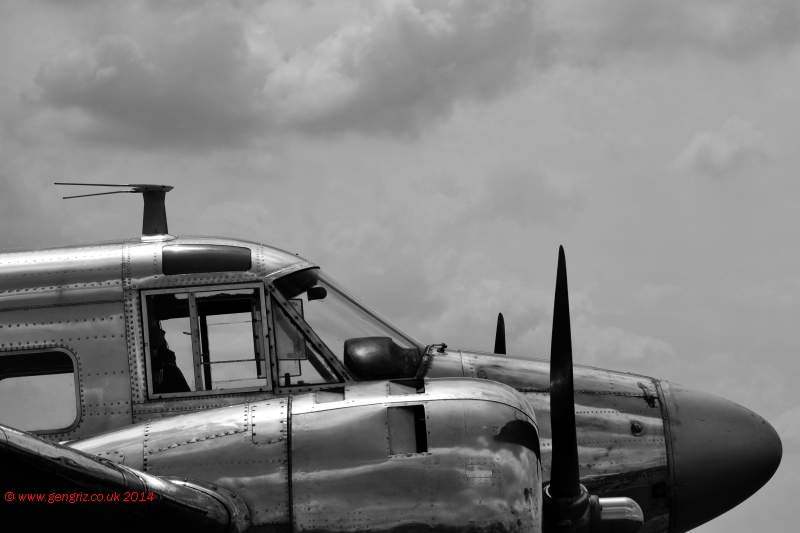
Some airshow pictures of the real thing:
